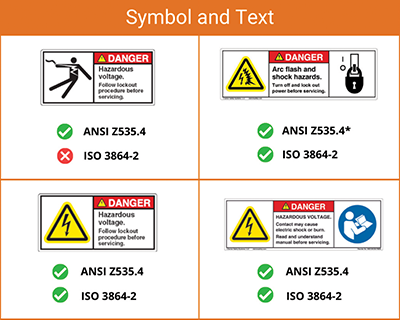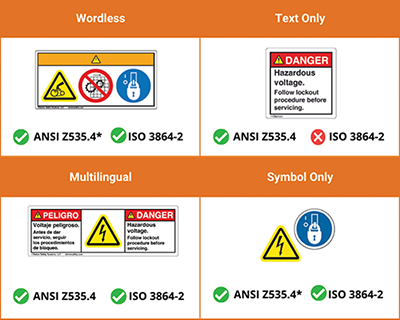In our last ‘On Your Mark’ column, we explored the product liability and legal landscape, noting how product safety labels are an important part of keeping users safe and reducing liability risk – as well as how industry standards like ANSI Z535.4 (domestically) and ISO 3864-2 (internationally) can be effective starting points in helping you to develop adequate warnings. “Warnings and instructions should be front and center for manufacturers. Warnings can be the downfall of a product but also its salvation,” trial attorney and product liability expert Cal Burnton told us.
When it comes to formatting options and symbol use in your labels, the current versions of these standards allow manufacturers to use a number of different options. So, how do you make the right decision for your products? “I recommend first understanding the standards-based options available to you, weighing the benefits and limitations, and then deciding which best conveys your safety message to your intended audience,” says Angela Lambert, head of standards compliance at Clarion Safety Systems.
Read on for a quick guide to understanding the considerations of the main label and symbol format options available to you, including pros and cons, and whether they meet the U.S. ANSI Z535.4 standards, the international ISO 3864-2 standards, or both standards.
Symbol-only Label Formats
This style of safety label uses only ISO-formatted symbols without a word message or an ANSI/ISO signal word panel. It meets both the ANSI Z535.4* and ISO 3864-2 standards. The benefits of this type of format are that it can communicate across language barriers without translations and that these symbols typically use less space than other types of formats. The limitations are that more than one symbol-only label may be needed to communicate the safety message, the severity of the hazard isn’t defined, and that symbol comprehension testing or training may be needed.
Symbol and Text Label Formats
This type of safety label uses ISO-formatted symbols with an ANSI/ISO signal word panel and word message. This format meets ANSI Z535.4, and meets ISO 3864-2 as well, as long as at least one ‘ISO-formatted’ symbol (meaning the symbol uses a colored, surround shape consistent with the ISO standards) is used. The benefits of this type of format are that multiple symbols can reinforce the message, the signal word panel defines hazard severity level, and a word message provides information on hazard and how to avoid it. The limitations are that space may be an issue, translations may be necessary, and some symbol and text label options don’t meet ISO 3864-2 (due to the ISO-formatted symbol requirement).
Text-only ANSI Label Formats
These text-based safety labels use an ANSI/ISO signal word panel and a word message. This meets the ANSI Z535.4 standard. It does not, however, meet ISO 3864-2. That’s because the ISO standard requires at least one ISO-formatted symbol to be used. A benefit of this type of format is that it requires less space and may work well when space is an issue. A limitation, aside from not meeting international standards, is that translations may be necessary.
Wordless ISO Label Formats
This format of safety label uses an ISO wordless format with a hazard severity panel. It meets both ANSI Z535.4* and ISO 3864‑2. Benefits of this type of format are that the hazard severity panel color-coding communicates the level of risk, and that the label communicates across language barriers without translations. The limitations are that the severity of the hazard is not defined in words, and that comprehension of both the symbols used and of the severity-level color-coding may vary.
Multilingual Label Formats
This style of safety label uses ISO-formatted symbols with an ANSI/ISO signal word panel and word message, accompanied by translated text. You may choose to use one combined, multilingual label, with English as well as another language on a single label, or you can use an ‘add-on’ label style, where you place a separate, translated version of the label beside the English version. Multilingual label formats meet both ANSI Z535.4 and ISO 3864-2. The benefits of this style are that translated text communicates to specific, target audiences. The limitations are that special care must be given to translations to ensure accuracy and that the translation matches with the intended audience, and that label installation prior to or after shipment must be taken into consideration.
The task of defining the proper content of your product’s safety labels is one that’s never finished. It’s an ongoing process. As you periodically re-evaluate your labels, reviewing the ANSI and ISO standards-based format options available to you can help to ensure you’re using today’s best practices. It can also help you to make sure that your label program is as effective as possible – and may open up new communication tactics as well as opportunities like consolidating your warnings.


*Note: The ANSI Z535.4 standard does not specifically include this label format. However, ANSI allows manufacturers to use it by way of its section 3.1.1, which allows for the use of ISO formats.
This article is courtesy of Clarion Safety Systems ©2023. All rights reserved.
